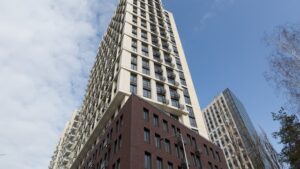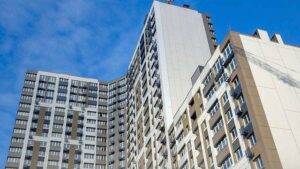
The death of Arseny Nasikovsky, junior partner of the DIM group of companies, has been announced. The news was reported by Arseny’s father, Alexander Nasikovsky, founder and managing partner of DIM. He noted that all initiatives and projects his son had been working on will be continued by the team and partners.
According to Alexander Nasikovsky, the initiatives that will be continued include:
— NAD (Nasikovskyi Arseniy Development) and ARS Capital — a development company and investment fund involved in affordable housing projects in Ukraine, the Maximus recreational thermal resort in Berehove, as well as commercial real estate projects and a fund to attract investment in the development of these areas.
— ARS Foundation — a charitable foundation that helps orphanages, orphans, and children left without parental care; the foundation provides regular support and is preparing to launch a new format of children’s homes in Ukraine.
— ANiMA — a network of eight wellness resorts in six regions of Ukraine based on the concept of wellness hedonism, each facility with its own history and atmosphere.
— NOVA — a business and travel club for entrepreneurs and conscious people united by a desire for development, discovery of the world, and exchange of ideas; it includes unique itineraries and a community of like-minded people.
The cause of his death has not been specified. Arseniy Nasikovsky played an active role in the company’s operational projects, overseeing construction and investment areas, supporting the development of the DIM brand in residential real estate.
DIM Group is a Ukrainian full-cycle holding company in the field of real estate development, founded in 2014. The holding company unites several legal entities: manufacturing, architectural, and construction companies, a real estate agency, and a management company.
The founder and key figure of the group is Alexander Nasikovsky, who is the managing partner. DIM’s project portfolio covers residential real estate in Kiev and the Kiev region — more than 800,000 m², with a significant part of the properties already commissioned or under construction.
The editorial team expresses its deepest condolences to the family, colleagues, and all who knew and appreciated Arseniy Nasikovsky.

A decrease in supply on the residential real estate market in Kyiv and stable demand from buyers are maintaining the upward trend in prices for new buildings. By the end of the year, the cost per square meter will increase by 10-15%, the DIM group of companies told the Interfax-Ukraine agency.
“According to analysts at the DIM group of companies and industry observations, if the pace of the second half of the year does not fall below that of the first, the city will receive approximately 12-14 thousand new apartments by the end of the year, which is 15-20% less than last year. At the same time, limited supply amid stable demand will contribute to a further 10-15% increase in prices in the primary market by the end of the year,” the group said in a statement.
According to DIM, in the first half of 2025, the average price of new buildings increased by approximately 14% compared to the same period last year. Thus, , the average cost per square meter in new buildings is currently about $1,000/sq. m in the “economy” segment, $1,300/sq. m in the “comfort” segment, $2,200/sq. m in the ‘business’ segment, and $4,400/sq. m in the “premium” segment.
At the same time, the rate of increase in housing prices on the secondary market in the capital is slower: in the first half of 2025, prices rose by 8-10%, and the average cost per square meter on the secondary market is $2,000/sq. m.
According to Arseniy Nasikovsky, junior partner at DIM, the ability to move into ready-built housing is the main factor in choosing housing on the secondary market. However, a further reduction in the supply of new buildings in the event of a deterioration in the security situation will also shift the focus to secondary market properties.
“The choice between primary and secondary housing in 2025 will depend on the balance between readiness, risk, and the buyer’s financial capabilities. If the buyer values the ‘move in and live’ formula, they will choose secondary housing. New buildings offer a fundamentally different level of comfort, primarily a new level of security, which is very important in wartime, modern layouts, energy efficiency, and the availability of shelters and parking lots,” the expert explained.
According to DIM’s forecast, the restoration of new construction volumes to pre-war levels can be expected no earlier than the end of 2027. Today, there are only 140-145 residential complexes for sale on the capital’s market, which is a quarter less than before the war.
The portfolio of the development company DIM consists of real estate in Kyiv and the region with a total area of over 900,000 square meters. More than 3,600 apartments have been commissioned, and more than 356,000 square meters of residential and commercial space has been built. Six projects with a total area of more than 346,000 square meters are currently under construction.
Analysis, DIM, KYIV, REAL ESTATE, WHEAT

Installment plans with extended repayment terms offered by developers are in high demand among home buyers and are an alternative to state mortgage programs, Ukrainian developers told Interfax-Ukraine.
“In 2024-2025, we are seeing an increase in the share of customers who choose long-term interest-free installments from KAN Development. This is due to increased buyer confidence in the future, especially given the improved security situation in Kyiv. The ‘єОселя’ and ”єВідновлення” programs have had a limited impact on our sales so far. Most customers choose other financial solutions, in particular, our own programs,” said the press service of KAN Development.
In recent years, there has been a growing demand for longer installment plans, noted Irina Mikhalova, CMO of Alliance Novobud. In addition, developers are offering programs with reduced down payments.
“At the start of construction, we can offer longer installment terms—12, 24, or 36 months. This is because, as a rule, installments are provided until the project is commissioned. We also frequently receive requests from buyers to reduce the down payment, which can be either 10% or 50%,” the expert said.
The Kovalskaya Group’s internal installment plans offer a fixed price per square meter for up to five years with a down payment of 30% of the cost of the home. According to the company, an individual approach to the buyer’s needs is practiced.
“Installment plans have become more flexible: if a customer realizes that they will not be able to make monthly payments, we are open to dialogue and ready to work together to find a convenient solution. It is possible to agree on an individual schedule, for example, to increase the installment period, temporarily reduce the amount of payments with a subsequent return to standard payments, carry out restructuring, exchange an apartment for another area or in another construction project,” explained the developer.
The company “RIEL” in the second launch complex of the capital’s Brother project offers buyers to purchase housing in installments until the facility is put into operation in the second quarter of 2028, said Alla Chipak, coordinator of the sales departments of “RIEL” in Lviv. In addition, in some residential complexes, the down payment has been reduced to 10% of the apartment’s cost.
Given the popularity of the developer’s renovation option, Intergal-Bud also offers the possibility of paying for renovations in installments along with the apartment, said Anatoliy Kovrizhenko, sales director at Intergal-Bud.
According to the DIM group of companies, developer lending programs with extended installment terms are an alternative to state mortgage programs with loan amount limits. The company has its own financial programs, under which the down payment is 30% of the cost of the property, and the installment term is up to five years.
In addition, DIM offers a long-term installment program of up to 10 years.
“In early June, we launched a long-term installment program in hryvnia for a term of 10 years, with the possibility of early repayment, a fixed price in hryvnia, a fixed price per square meter in the contract, without reference to the exchange rate or market price increases, with a fixed interest rate of 10% per annum in hryvnia and a down payment of 30%. It was planned to launch as a pilot project for two months, to test it in large complexes of quarterly development such as Metropolis, Lucky Land, and Park Lake City. However, we received quite a few inquiries from buyers, which turned into real deals, so we continued the program until the end of the summer,” said DIM managing partner Alexander Nasikovsky.

About 65% of all home purchase deals in the new-build market are concluded under installment plans offered by developers, while the share of purchases with full payment varies between 25% and 60%, according to the results of a survey of Ukrainian developers conducted by Interfax-Ukraine.
“Before the full-scale invasion, the percentage ratio of methods of purchasing residential real estate at Alliance Novobud was as follows: 25% – full payment, 65% – installment plans from the developer, 10% – bank mortgages. As of today, this ratio has changed: 10% – full payment, 65% – installment plans from the developer, 25% – partner mortgages, “єОселя” (єHome), ‘єВідновлення’ (єRecovery),” said Irina Mikhaleva, SMO of Alliance Novobud.
According to her, the share of the developer’s apartment sales under the state affordable mortgage program “єОселя” accounts for up to 15% of the total. Transactions with “єВідновлення” certificates are rarer – 1-2 transactions per quarter.
In the sales structure of the DIM group of companies, about 65% of transactions are accounted for by its own installment programs, 30% are concluded with full payment, and only 5% are under the “єОселя” program.
“DIM joined the ”єОселя” program last year, and immediately about 30% of all inquiries to our sales offices were related to this program. Of these, about 10% turned into actual deals. In 2025, the number of requests among buyers of comfort-class housing for “YeOselya” increased to 40%, and more than 25% turned into actual deals. However, there are still barriers to increasing volumes due to limited credit resources,” said DIM managing partner Alexander Nasikovsky.
City One Development reported that the share of installment deals is significant in both comfort-class and business-class projects, reaching 70%.
“The market has become more diversified. Buyers choose not only based on price, but also on convenience, stability, and long-term guarantees. Installment plans from the developer have become a key tool for most of our clients, regardless of the class of housing,” explained the developer’s press service.
However, although the share of 100% payment deals is decreasing, one-bedroom apartments are still mostly purchased with full payment.
“In general, the share of 100% payment deals is decreasing, which is natural in an unstable economy when most buyers are looking for more convenient and predictable financial solutions. On the other hand, one-bedroom apartments, as before, are mostly purchased with full payment. This is typical for investors or those who have a clear financial plan and want to fix the price at the start of construction or get the maximum benefit,” City One Development noted.
According to Anatoliy Kovrizhenko, sales director at Intergal-Bud, since the start of the full-scale invasion, the number of deferred payment agreements with the developer has increased by approximately 15-20%.
“This is due to buyers’ desire to maintain liquidity, spread the financial burden over time, and minimize their own risks,” he explained.
At the same time, agreements under the “eOselya” program account for 15% to 35% of Intergal-Bud’s total sales, depending on the month, Kovrizhenko added.
Meanwhile, the Kovalskaya group notes an increase in the share of full payment for housing during the construction phase.
“We have a clear trend: more and more people are choosing to pay in full at the construction stage. While in 2023 such agreements accounted for just over 20%, in 2024 they will account for almost 30%, and in the first half of 2025 – over 50%. This indicates growing confidence in reliable developers and investors’ desire to lock in the price per square meter at an early stage,” the company said in response to a request from Interfax-Ukraine.
According to the company, the state program “eOselya” is also showing positive dynamics: in the first half of 2025, it accounted for 25% of all developer deals, which is 2.5 times more than in the second half of last year.
A significant share of transactions with full payment was also reported by the company “RIEL.” As noted by Zoryana Zemlinska, coordinator of the sales departments of “RIEL” in Kyiv, in Kyiv projects, about 50% of transactions are concluded with full payment, and in Lviv, this figure is even higher—60%.
The developer also noted a positive trend toward purchasing housing through the “єОселя” program.
“The trend towards purchasing housing with the help of the state program ”єОселя“ continues. If in 2022 we had a total of 5% of deals under the ‘єОселя’ program in Kyiv and Lviv, then in 2025 this figure will increase to 13%,” Zemlinska said.

Foreigners’ interest in purchasing premium housing in Ukraine for investment purposes is gradually recovering, developers told Interfax-Ukraine.
“Interest from foreign citizens has recovered, and in some cases, such as our projects, the number of deals with foreigners exceeds the number of deals with Ukrainians. Our clients include Spaniards, Japanese, Canadians, and others who are investing in business and premium class properties with a clear focus on the future. They see potential in both long-term rentals and growth in value,” said Irina Mikhaleva, CMO of Alliance Novobud.
According to Susanna Karakhanian, sales director at Greenville, foreign clients are considering both investment purchases and homes for themselves, but are postponing their purchases until safer times.
“Interest from non-residents has partially recovered recently. We are seeing a trend where foreigners regularly visit apartments, but are not buying yet — deferred demand, waiting for stabilization in Ukraine,” she explained.
Although the apartments of the Odessa developer “Two Academics” are mainly purchased by local residents (up to 60% of customers), the share of deals with foreign investors has increased over the past year and a half, the company said.
“In terms of geography, 55-60% are local residents, in our case Odessa. Up to 30% are from other cities in Ukraine. However, over the past year, these figures have begun to change with the emergence of foreign investors. For the period 2024-2025, 35% of deals are being made with foreign investors: the UAE, Slovakia, Turkey, Italy, the US, Greece, Israel, and Romania,” said Maxim Odintsov, development director of the construction company Dva Akademika.
In addition, foreigners continue to show interest in Ukrainian residential projects where foreign companies are involved as partners, according to RIEL.
“We have projects that foreigners are quite interested in. For example, Maxima Residence has traditionally attracted foreigners, particularly Turkish citizens. This is because it is a joint project between RIEL and Turkish developer Bosphorus Development,” explained Zoryana Zemlinska, sales coordinator at RIEL in Kyiv.
At the same time, KAN Development noted that the share of foreigners among buyers remains insignificant, and demand for premium housing is largely recovering due to people who invested before the war.
“The share of foreigners among buyers remains insignificant. These are mainly those who are considering investing with the expectation of a minimal cost of entry into the market,” the developer’s press service said in response to a request from Interfax-Ukraine.
According to Alexander Nasikovsky, managing partner of the DIM group of companies, Ukrainians who have been living abroad for a long time have appeared in the structure of demand for premium housing.
“We are observing the following trend: some buyers who have free funds are deliberately not taking them abroad, but are ‘parking’ them in real estate with a view to future price growth and preservation of asset value. As for foreign citizens, we do not see any activity on their part for reasons that are understandable to everyone. However, there is a small share of Ukrainians who have been living abroad for a long time,” the businessman noted.

DIM Group of Companies has launched the DIM REALT affiliate program for realtors and brokers, with transparent terms and a focus on long-term cooperation, the company’s press service reports.
The release notes that as part of the program, DIM provides access to its own closed brokerage ecosystem, in which partners, in particular, receive an agreement with clearly defined terms, roles and regulations; a transparent payment system without delays and hidden sub-clauses; exclusive conditions for objects, including presale conditions, etc.
The key focus of the program is on professional support and deep involvement in the company’s products. To this end, DIM organizes special Property tours for brokers with the participation of a team of architects, project managers, and sales, during which partners will be able to see all the nuances and conceptual features of the objects from the inside.
The portfolio of the development company DIM consists of real estate in Kyiv and the region with a total area of over 900 thousand square meters. More than 3.6 thousand apartments have been commissioned, and over 356 thousand square meters of residential and commercial space have been built. Six projects with a total area of over 346 thousand square meters are under construction.